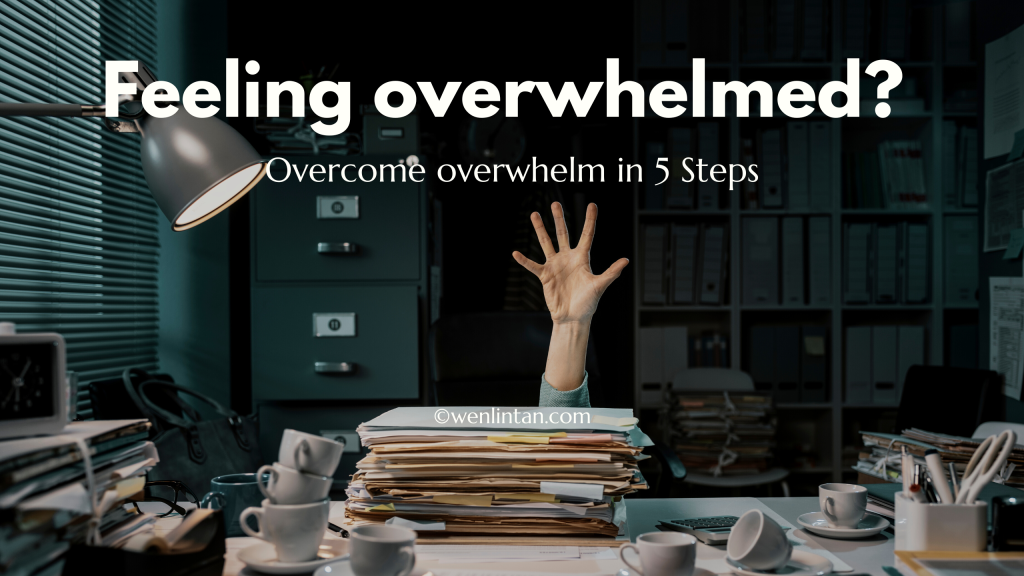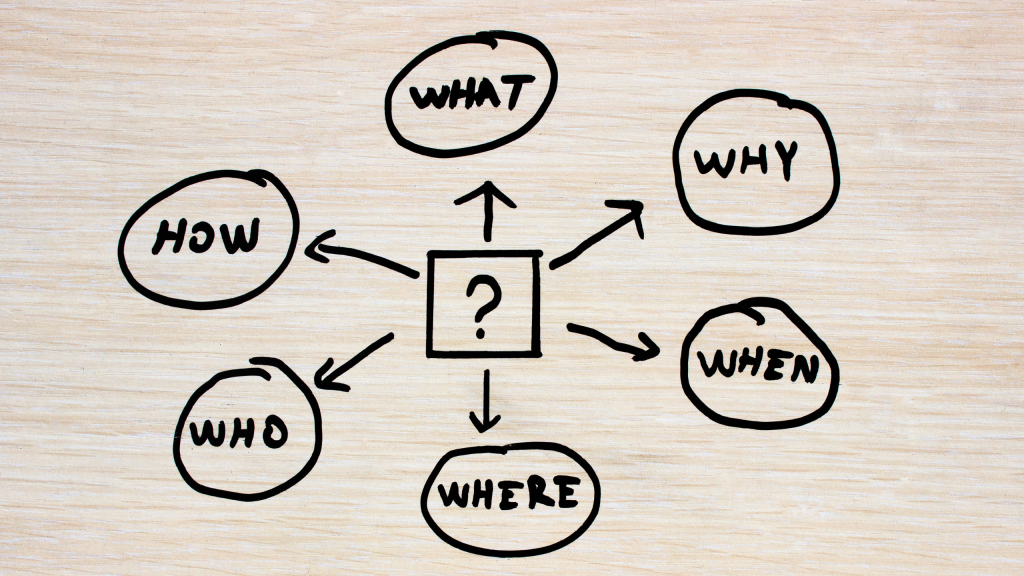Overwhelm: How to manage it in 5 Steps
Overwhelm is a feeling that can manifest in many different ways, but at its core, it is the experience of feeling like there is too much to handle, which can be caused by a variety of factors, including time constraints, emotional stress, decision-making pressure, information overload, and relationship challenges. In this article, you’ll learn a 5 step process to help you overcome overwhelm to help you find calm, clarity and release stress, anxiety and negativity.

Then, you’ll also learn about the five types of overwhelm, be guided to identify the kind of overwhelm you’re experiencing, and long term strategies to help you address the root cause(s) of the overwhelm so you can move forward and prevent overwhelm from happening again. First, here’s a simple, quick and effective 5 Step framework to overcome overwhelm:
5 Steps to overcome overwhelm
Step 1: Hit Pause, create safety 🦺
⏸️ First, hit pause. Temporarily withdraw from the situation or create a safe space for yourself, if possible. This might be a physical or mental space. It is easier to overcome overwhelm if you create safety from the overwhelm / triggering situation.

A safe space can be created through various ways. Try these:
- 😮💨 Close your eyes and focus on your breath – if you are alone by yourself and feel overwhelmed by the thoughts, stress from obligations and/or tasks you have to fulfill, you can try half or fully closing your eyes and diverting your attention to the rise and fall of your breath.
- ❤️ Press the heart protector button – A quick, inconspicuous and effective technique to create safety while connecting to your heart space is pressing down on or massaging the the LaoGong 劳宫 acupressure point (Pericardium 6) in the centre of one palm with the thumb of the other. The pericardium is a thin sheath that wraps around your heart, your heart protector, a blanket that keeps your heart safe. Pressing this safety button helps opens the chest, regulates Heart energy, calms the spirit. It is also helpful in treating insomnia and calming the spirit in triggering situations.
- ⭕ Physically withdraw – if possible, when you are in a situation with someone else e.g. a family member or a colleague, letting them know that you need a moment for yourself, either in silence in their presence or even in a separate space e.g. the washroom, can be powerful in dissolving or reducing feelings of overwhelm. Physically withdrawing helps create a safety bubble for yourself, reducing the closeness to the overwhelm.
Step 2: Remind yourself you are not alone 🤗
🤲 Remember you are not alone. If you’re experiencing overwhelm, before taking next steps it’s important to acknowledge that you’re experiencing a challenging situation that others experience too. In a recent research I conducted online with 72 women mindfulness practitioners experiencing overwhelm, 3 in 5 of them said they experienced overwhelm in the last 2-3 days, and more than 2 in 5 of them mentioned that feeling alone was one of the key reasons contributing to their feelings of overwhelming. Remembering that you are not alone in your experience of overwhelm can reduce it’s negative impact on your mental, emotional and physical state.
To remember you aren’t alone, try repeating the following mantras:

- “I am enough, and I get better everyday.” – This mantra is especially relevant if you’re struggling with overwhelm from perfectionism, or negative self-talk that is stopping you from moving forward.
- “I am not alone, I am held, supported and safe.” – A helpful mantra to create a feeling of safety and connectedness.
- “I’m okay, things are ok” – This is a particularly helpful mantra if you are struggling with a challenging situation and feel fearful that things may worsen or get out of control.
- “I don’t have to do/ understand (everything) / (now)” – A helpful mantra when you’re feeling overwhelmed by having too much to process or do at the same time.
Step 3: Take a moment to process your situation⌛
🚧 Take some time to process and acknowledge the sensations, thoughts, feelings unfolding in the moment. This will be helpful for you in uncovering the root(s) of the overwhelm so you can better equip yourself with the necessary tools to respond to potential triggers of overwhelm in the future. Some ways of doing this are:

- 💬 Verbalise the thoughts to yourself / someone else. You might try saying aloud to yourself or someone else – I think…. I feel…. I am… and allow any words that arise describe the situation you are in, how you are feeling about it, what you are thinking about it and how it is affecting you.
- ✍️ Journal the thoughts, emotions, sensations in stream of consciousness writing i.e. not censoring yourself, to the best of your ability. The act of writing allows these challenging thoughts, feelings, sensations to exist in a space outside of you, and also empowers you to be able to process them at a later them when you more objective.
- 👁️ Observe the thoughts, emotions, sensations in meditation. If possible, take some moments to notice the layers of overwhelm in your present experience. This leads on to step 4, identifying the type and cause of your feeling of overwhelm.
Step 4: Identify the reason why you feel overwhelmed, the root cause 🌱
This step is all about uncovering the underlying triggers and root of any issue(s) leading to your feeling(s) of overwhelm, and is most effective shortly after you’ve followed steps 1-3 to create safety for yourself, soothe yourself and processed (at least briefly) what happened. It’s important to only proceed with this step when you feel safe and are able to objectively reflect on the situation.
Go through these prompts to reflect on to help uncover the causes of your overwhelm based on the 5 W + 1 H framework (What, Where, Who, When, Why and How):

- What happened?
- Where and When was I? (this could be an actual physical space or a non-physical mental / emotional space e.g. a memory from the past, or a projection of the future)
- Who was involved? Were there others involved? If yes, who? What did they do / say ?
- How did I feel? How did I respond? How did the others respond?
- Why was I did I feel overwhelmed?
As you’re doing this, notice if any of the following 3 occur:
🔎 Past/future-related fears:
Harvard researchers found that on average the mind wanders 47% of the time. Look out for instances where the overwhelm came from a time other than now – from the past (e.g. the memory of having had struggled in the past) or something in the future (e.g. fearing potential financial instability in the future. Staying focused in the present can reduce stress and overwhelm. When dealing with these past or future-related fears and worries (‘What if?’), the solution lies in creating safety now and staying present and reminding yourself to take things one step at a time.
🔎 Negative self-talk/beliefs:
Observe if the overcome comes from negative self-talk, self-limiting beliefs. A critical inner dialogue sets you up to fail because it emphasizes what has gone wrong in the past, then uses that information to predict things going wrong in the future. The key to resolving these lies in Self-Talk training. First acknowledge and notice negative self-talk, then reframe it into empowering thoughts.

Scientific research conducted by Sport Journal has found that Self-talk training is effective in reducing somatic state anxiety and (higher) state self-confidence, self-optimization, self-efficacy, and performance of athletes. Some common examples include:
- ‘I’ll never be able to complete this in time’ → ‘There are ways and means of support to help me complete this in time’
- ‘I’m not good enough’ → ‘I am enough, and I get better everyday.’
- ‘I’m alone, no one can understand or support me’ → ‘I am not alone, I am held, supported and safe.’
🔎 Assumptions/jumping to conclusions:
Notice where you may have jumped to conclusions / made assumptions which may or may not be true:
- e.g. my boss thought I wrote the report poorly vs. my boss frowned as she looked at my report,
- e.g. my spouse isn’t supportive of me vs. my spouse did not respond to my message
Question any underlying assumptions and ask, ‘Why did i jump to this conclusion? Is this really true? ‘What is really true in this situation? What was the root that resulted in my experience of overwhelm?’ Focus on the facts – what was factual, objective and observable.
Step 5: Identify the type(s) of Overwhelm & pick a long-term strategy to overcome it
Once you’ve reached this step, you’ve probably gotten a clearly ideal of the underlying issue(s) resulting in your experience of overwhelm from Step 4. Now you can identify the main kind(s) of overwhelm you’re experiencing and start to work on strategies to help you overcome and prevent future instances of overwhelm.
There are five main types of overwhelm: Time overwhelm, emotional overwhelm, decision overwhelm, information overwhelm and relationship overwhelm. Though it’s likely that the overwhelm you’re experiencing is a combination of 2 or more types, often you’ll find that there is one main type of overwhelm that is the root cause, that once solved will also resolve the other associated overwhelms. Identify this main type of overwhelm and pick one strategy to dissolve this overwhelm. Read more about the Five types of Overwhelm here.
Overwhelm can manifest in many different ways and it is important to be aware of the different types of overwhelm. By identifying the specific type of overwhelm, you can take steps to manage and overcome it. It is important to remember that it is okay to feel overwhelmed. Did you try the four step approach to overcome overwhelm, and how did it go for you?
Are you looking for support to manage mental or emotional overwhelm?
Through coaching with We identify the triggers underlying situations causing your experience of overwhelm. You’ll learn effective and simple tools to dissolve overwhelm, and long-term strategies for preventing overwhelm.
Take my highly-rated course, Overwhelm to Ease: Powerful Time & Energy Management Hacks to help you dissolve overwhelm,
Prefer to work 1-on-1? Book a complimentary call with me and find out more about coaching with me here
Below you can explore insights from the research I conducted on overwhelm

This Post Has 0 Comments